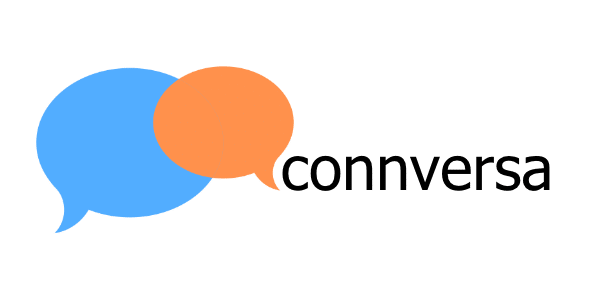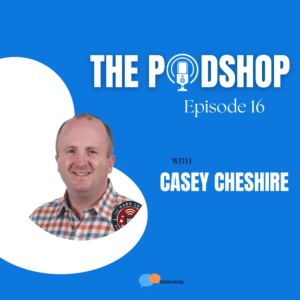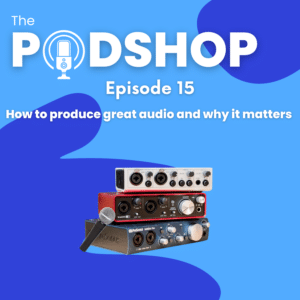Planning, launching, and running a branded podcast is a lot of work. But if you have a solid branded podcasting plan and are willing to learn the basics of recording, editing, and producing audio and video, a B2B brand can produce a podcast to grow brand awareness and create lots of high-end content.
In this episode of The PodShop: Your Comprehensive Guide to B2B Branded Podcasting, Jeremy Shere, founder and CEO of Connversa Podcasting, talking with Alan Silvestri, founder and CEO of Gorilla Growth, about how and why Alan started his company’s podcast, “Promote or Die!”
In this episode:
- The concept behind the Promote or Die! podcast: content must be promoted or it will die
- Alan started a podcast to increase brand awareness and spread the word about what they do
- Alan’s systematized process of recording, editing, creating social material, and distributing which takes him two to three hours per week
- Recording episodes in advance to build a backlog
- Using Riverside to record audio and video
- Editing the audio with Descript, using the transcript to take out parts, mute words, and sounds
- Creating a final composition in a music recording software with intro and outro music and voiceover
- Uploading the podcast to Buzzsprout and creating a blog post for each episode
- Posting the transcript on the blog post for SEO benefits
- Find a gap in the market to fill with a podcast.
- Try to get some big names as guests but focus primarily on other SEO agency people
- In-house people make great guests due to their unique stories
- Focus on day-to-day work stories for listeners
Watch a condensed version of the episode:
Full Transcript
Jeremy: Hey everybody. Welcome to the show. Whenever I come across a B2B brand that has a podcast, it warms my heart because I know podcasting is a great marketing channel for B2B, but still only around 25% of B2B brands have a podcast.
But when I come across a B2B brand and business owner that is doing podcasts, I’m impressed. This is somebody who gets it, and that is true for my guest for this episode. Alan Sylvestri, Owner and CEO of a company called Growth Gorilla, which is a content promotion and distribution agency. And as part of his marketing, Alan has a podcast with one of the great titles I’ve come across – Promote or Die! So Alan, welcome to the show.
Alan: Hi Jeremy, and yeah, I’m glad you like the name.
Jeremy: Naming a podcast isn’t easy. I know with our clients sometimes we spend a long time trying to figure out what to call it. How did you come up with Promote or Die?
Alan: Yeah. So, it all started from the concept that I call the content graveyard. In our agency, when content is not doing much for the business, it’s like, if you don’t promote then you die or your content dies. And then I decided, Promote or Die sounds kind of like an eighties movie. I like it. So that was good.
Jeremy: Yeah, that’s right, like starring Stephen Segal or something like that. Right? By the way, listeners, Alan is a huge eighties fan, both in movies and music too. Alan: Yeah, yeah, yeah. Music. I love music and cars, specifically a DeLorean of which Alan is a proud owner.
Jeremy: Okay. So let’s talk about your podcast. My first question is, why did you start a podcast?
Alan: Yeah. So I guess the main reason is because I feel like we are good at what we do, but the problem is, we needed more brand awareness. That’s the number one reason. I wanted to spread the word about what we do because I think we’re good and quite unique in what we do. I also wanted to talk about all the different types of promotion and not just what we do, which is more link building, content promotion. I saw a friend of mine that is another agency had started a podcast last year and it was going really well. There were a lot of other people in my network that had started a podcast in the last year or so. So I decided why not us as well?
Jeremy: Okay. And now a podcast is quite a bit of work compared to starting a blog. You need to figure out the recording, microphone, editing and other steps. Did you have any experience with audio recording going into this?
Alan: Yeah, so to be fair, yes, I played in a band for 15 years and so I was recording all of our demos as well. So I knew how to use some of the recording software and do editing. I’m also good at systematizing things. I have a distribution checklist, a production checklist, and a prep document that I send to all the guests with everything they need to do before the show. It probably takes me two to three hours per week to get an episode out there between the editing, creating the social material for the distribution and everything else. I’m looking forward to delegating or having someone else do it in my team, but for now it’s still working quite well and I can manage.
Jeremy: So you mentioned you have checklists for, let’s start with production. So what does your production process look like?
Alan: Yeah, so I try to record as many episodes as I can in advance to get a backlog, you know, so that I don’t find myself one weekend without anything to publish. Then in terms of production, it’s, once I recorded the episode, I record with Riverside like you guys do. I then download the audio for the two separate tracks and the video. For both guests together from Riverside, and then I put them into Descript. It gives you the transcript for the audio so that then you can edit using the transcript itself, so you don’t have to look at the audio wave. So you can just use the transcript to take out bits or text parts that you don’t want to have. You can also mute words or like sounds. It’s like an automatic process. That’s been very helpful. Cause otherwise I couldn’t really see myself doing the editing on the audio wave track.
Then I export that and I create my final composition in a music recording software where I had my intro, my music for the beginning and, and the outro, which I have pre-recorded. I went to a free soundtrack website for royalty free music. And I got this eighties song kinda like synth waves. I also did voiceover myself with a lower pitch that sounds kind of like a horror movie voice. So yeah, this is how I compose the episode. And then I use Buzzsprout to upload the podcast and to get it onto all the directories. I create a blog post for each of the episodes. In the blog post, I typically have the player, I have the main takeaways, and then I have the transcript as well as the YouTube video, right? Because I also post the video on YouTube. Jeremy: Right. Okay. Yeah. I noticed on your, you post the entire transcript of each episode. What’s the strategy there? Alan: Yeah, so, although it doesn’t look great, the main reason is for SEO benefits cuz I think there still will be a lot of keywords in there. A lot of like phrases and stuff that Google can use to possibly index my podcast block page. So yeah. Yeah, I would say SEO is the main reason for that.
Jeremy: If I’m hearing you correctly, you’re repurposing the podcast as content and distributing it across different channels.
Alan: Yeah, I try to do the bare minimum. I still don’t know what will work best, so I create two audiograms, two social media images with a quote for the guest, a YouTube video, blog article, and directories. I’m only at the third episode now, so I don’t have much data to see what works best. Eventually, when I know what works best, I can scale up and dial down something else, maybe.
Jeremy: Right. Yeah. It’s a great way to, to create content and have a consistent cadence for yourself and for the people that are subscribed to the newsletter. It’s one of the main values I see of podcasting, that it’s having a 20-25 minute conversation with somebody is a pretty natural thing to do. It doesn’t take a ton of prep and you can spin that out into so much other content that, without it, would take a lot longer. Starting with a conversation just speeds up the whole process.
Alan: Mm-hmm. Yeah. And I also send the podcast each week to my agency’s newsletter. We don’t have many subscribers, but I wasn’t doing anything with it until now. I have this weekly cadence I can use for the podcast and other things. This morning, for example, I sent out today’s episode, plus a couple of other updates on the agency. Having the podcast helps me create a schedule to put something out there for the newsletter, which is always good.
Jeremy: How do you go about finding guests?
Alan: I have a specific process that I follow. I want to test a segment for specific podcast types, like B2B SaaS podcasts. I go into iTunes and type SaaS. This gives me different SaaS podcasts. I open the ones that inspire me, and check if they’re still publishing a podcast. If they have a website, I do a Google search using the advanced search operator, plus their site, plus my topic. This gives me an idea if they already talked about my topic. I use this in my email template. I mention one of their latest episodes to show I’m an active listener. I mention the topics they’ve been talking about and add one they haven’t talked a lot about. I name drop and say I’d love to have the opportunity to help their audience learn something specific to the podcast.
Jeremy: That’s a great process. I love that you make it so personalized. You’re not just spraying out a bunch of invites, you’re really targeting people in a very specific way.
Alan: Yeah. So it’s still definitely very manual so far. I found that in two hours per week, I can send out five emails. Super targeted and customized. I’ve been doing this for the last couple of months and it typically gives me one podcast per week. So I know that if I can scale this up and maybe get more help with the research, then we can possibly increase the number.
Jeremy: Right. So you’ve figured out who you want to talk to, how to reach them, and then you can scale it. Is there anything about producing a podcast so far that’s surprised you or was different than what you assumed it might be?
Alan: Yeah. Just the overall experience. I was surprised to see how well people reacted, even though it’s super new and we just have three episodes. I was surprised to see the snowball effect of some of these things. I send the guests all the sharing materials so they can spread the word too. It’s quite nice to sit back and see everything spread out using automation tools and a little bit of networking. So yeah, I think moving forward could be something very positive for the business.
Jeremy: So what would be your advice to a B2B marketing team that’s thinking about doing a podcast?
Alan: I would say find a gap in the market that fits within what you do. For example, I noticed that there were a lot of podcasts on content marketing, SEO content strategy, marketing in general but there weren’t many podcasts on content promotion itself, which is what we do. Another idea I’m starting to explore is getting guests who are mostly my friends. I’m trying to get some bigger names but primarily they are other agency people. However, since I got a couple of in-house people, I know they are better. The reason being they have unique stories to tell. People from agencies are typically good at describing their process but in-house people have stories from their day-to-day work which is more interesting to listeners.
Jeremy: I agree. Podcasting is a natural storytelling medium and it’s smart to target those people more likely to have those kind of stories. If you’re a smart podcast host, you can ask for those stories.



